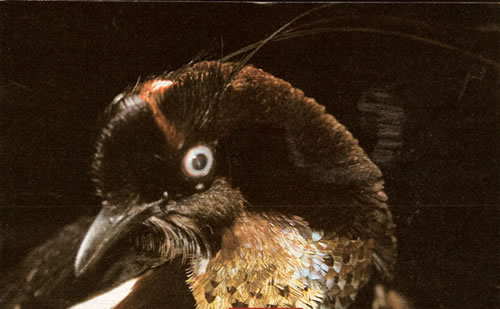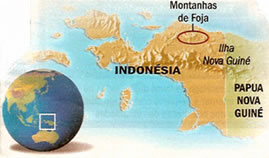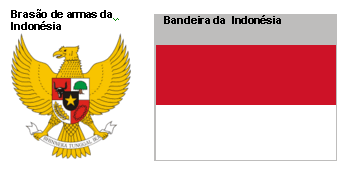|
|
DISCOVERED NEW FAUNA IN INDONESIA
(Notice published in the periodical "the Globe" - 2-8,2006)
Discovered Lost World in Papua - Expedition finds an area never visited by the man, with sets of ten of unknown species - See photographs below and read the notice and the summary.
 |
| The bird-of-paradise of Belephsch: described on XIX century and never more sighted again , the cientists believed that it was extinct. (Parotias belephsch) |
Expedition finds area never visited by the man,with sets of ten of unknown species .
JACARTA. "In a completely unknown region for the man, in isolated forests of Indonesia, an international team of scientists discovered a true lost world that shelters at least 150 species never seen of animals and plants and others that were believed total extinct.
The expedition to the Foja mountains, in the province most eastern of Indonesia , Papua, occurred in December of the last year and congregated 25 specialists of the United States , Indonesia and Australia , under the coordination of the ONG International Conservation.
 |
|
| Local of Discovery: Province of Papua , forest in
Foja Moutains , Indonesia |
New Species : lower case frog |
- It is the next of the Garden of Eden that we can find in the Earth - said Bruce Beehler, one of the leaders of the expedition and vice-president of the Center for Conservation of the Biodiversity of the Melanesia , that belongs to the ONG . - The first bird that we saw in the encampment was a new species. Great mammals that had been hunted until almost the extinguishing in other parts of the world appeared in abundance.
Official Name : Republic of Indonesia .
Localization : In the Southeast Asian . It encompass most of the territory of the biggest archipelago of the world, the Islands of Sonda and the half occidental part of the New Guine.Bathed in its eastern part for Indian Ocean and, in its occidental part , for the Pacific Ocean.
Territory : It possess about 2 million kilometers squared, distributed in more than 17,000 islands, 6,000 of the which uninhabited ones. The island of Java is the most important. The country is divided into 33 Provinces. Papua: where took place the discovery, is the most eastern province of Indonesia, next to Papua-New Guine, whose name comes from the tribe of aborigenes that inhabited the region, the papuas.
Geographic aspect of almost territory : Coastal plains and interior mountains.
Form of Government : Presidentialist republic. Division of Executive (Presidentialist system), Legislative and Judiciary.
Climate : equatorial in the lowest regions and cold in the highest regions .
Flora and Fauna : As a result of its great territorial extension, with extensive fertile area and an ample tectonic division, Indonesia possesss an exuberant vegetal and animal life, being that some exemplary ones only exist in this country. In the part east, the areas most barren, the fauna and the flora are similar to the ones of the Australian type, and in the other areas of the east, the Asian types.
Religion : More than 80% of the indonesians are Muslim and, approximately 10%, Christians (protestants, 6% and catholics, 3%);Hinduists, 2%, Buddhist and others, 1%.Some part of the religions have a local compound with old beliefs and traditions, that cult the spirit of the nature, including mountains and great trees and honor epirits of ancestrals.
Language : official language, the Indonesian; more 250 local languages of Malaysian-Polynesian and Papuasian, being the most important the Javanese.
Principal products : oil and gas - great producer, is the only Asian country member of the OPEC (Organization of the Producing and Exporting Countries of Oil); spices, mainly carnation; bauxite, gold, silver, copper, tin; industrialized agriculture and products.
Currency: Rupia
Population : about 224 million inhabitants, being the Island of Java the more populous. It is one of the most populous countries of the world. |
|

In this archipelago there have been made some interesting discoveries on still unknown species for us. It is the called specialization process (is a special mechanism of creation of inexistent species in other regions that appear in definitive one in reason of its peculiar conditions ).In 2004, in the Island of the Flowers, next to Papua-Nova Guiné, that makes border with Indonesia , there had been discovered fossils of a dwarfed, descending hominid direct of the Homo erectus , that lived there has about 13.000 years , which was called Homo florensiensis . The currently more accepted hypothesis for this finding is of that the Homo erectus arrived there has about 800.000 years, and, due to food lack and the type of resources of the place, was diminishing of size. The same it would have happened with the pygmies elephants that also would have inhabited this same island in the past. Jeffrey Schwartz, anthropologist and historian of science of the University of Pittsburgh , specialist in evolucionism, interviewed for the magazine "SEE" ("VEJA") , declared:
- We do not know accurately what types of change had affected the species of mountains of Foja, but with certainty its isolation was a determinative factor so that they became only in the region
|
|
New species : Kangaroo- of- golden- shawl
Dendrolagus pulcherrimus |
New type of bird-of-honey : bird with yellow plumation
|
Unknown areas can exist in the South America
"To all, 150 new species of animals had been found . Between them, 40 of mammals, 20 of frogs and four of butterflies. One of the new discovered mammals is the kangaroo-of- golden-shawl ( Dendrolagus pulcherrimus) that lives in trees. Between the birds, a type of bird-of-honey until then unknown was found. The bird-of-paradise of Berlepsch ( Parotias belephschi) , described the first time in ends of the XIX century, but never more sighted. The expedition also detected four unknown species of palms.
The scientists believe that similar discovery can come to happen in Africa and the South America ."
SOURCES : "O GLOBO", Brazilian Newspaper, 2,8-2006,p.30
"VEJA" , Brazilian Magazine, 2,15-2006, pp.96-97
PHOTOGRAPHS : OGN International Conservation
|